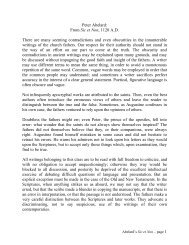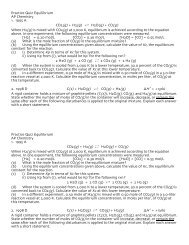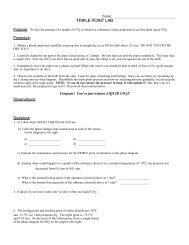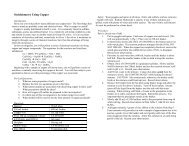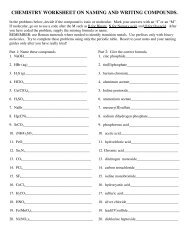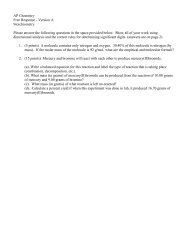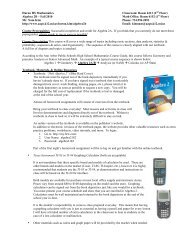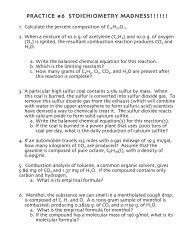Determination of Reaction Order â AP Chemistry Lab - Huron High ...
Determination of Reaction Order â AP Chemistry Lab - Huron High ...
Determination of Reaction Order â AP Chemistry Lab - Huron High ...
Create successful ePaper yourself
Turn your PDF publications into a flip-book with our unique Google optimized e-Paper software.
Data and Calculations:<br />
Trial Amount <strong>of</strong> 6.0M<br />
HCl diluted to<br />
24 mL<br />
1.<br />
[H + ] ln[H + ] Time <strong>of</strong><br />
reaction (t)<br />
(sec)<br />
1/t 1/[H + ]<br />
2.<br />
3.<br />
4.<br />
5.<br />
6.<br />
Carefully graph ln[H + ] on the y-axis and t on the x-axis, drawing a line <strong>of</strong> best fit. Use your calculator to<br />
perform a linear regression. Carefully graph 1/[H + ] on the y-axis and t on the x-axis, drawing a line <strong>of</strong> best<br />
fit. Use your calculator to perform a linear regression. Note: there are many other ways to represent this<br />
graph with the data/calculations listed above. It is up to you to understand the math and the relationships <strong>of</strong><br />
these variables to the line equation.<br />
Which graph is linear<br />
What is the slope <strong>of</strong> the graph<br />
What is the y-intercept<br />
What is the order <strong>of</strong> the reaction with respect to hydrogen ions<br />
Determine the value <strong>of</strong> the rate constant.<br />
Post-<strong>Lab</strong> Questions:<br />
1. Why does reaction rate usually change as the concentration changes<br />
2. Why does the reaction rate usually change with temperature<br />
3. What is the difference between reaction rate and specific rate constant<br />
4. How could you improve your data



